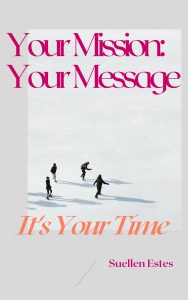
by Suellen | Marketing Success, Successful Living
Or, this article could be titled Three Ways Not to Fail Like a Cowbird.
My husband took this picture in our backyard yesterday. {You know, he’s the one who takes all the bird pictures you see on my sites).
Well, if you’ll notice, the tiny little Brown-Headed Sparrow is feeding the huge juvenile Cowbird. It’s a funny sight, for sure, and makes you wonder why.
Unless you know about Cowbirds.
You see, when a mother Cowbird has an egg to lay, she refuses to take responsibility. So she finds another bird nest – with eggs in it, and lays her egg there. Sometimes, she even knocks an egg out of the nest to make room for hers.
But then she’s off – to no telling where. Free from any responsibility.
In the meantime, the surrogate mother sits on this egg, hatches it, and feeds the young bird until it’s ready to fend for itself. The baby Cowbird thinks that this is her mother.
Thus, this amazing photo.
When I look at this, I see an analogy to our online businesses, and I think about the lessons available. Truly we don’t want to live the unfruitful life of a Cowbird, so what can we learn?
Tip #1: Take Responsibility
When we start our online businesses, we usually know very little. We have to learn the tricks. How do we set up our sites, write blog posts, line up our email accounts, and get traffic? And so forth.
There’s a lot to learn, for sure. And it’s easy to stay in that “I just need to learn one more thing” mode.
So we can buy shiny object after shiny object, and listen to webinar after webinar, without ever grabbing the reins of our own business and taking charge.
We somehow are expecting someone else to do it for us.
If we learn enough, it might just happen.
But that’s not how it works.
For us to succeed online – or in any endeavor – we have to take charge of our own business. We own it. We put the training together in our minds as to what will help us fulfill our mission.
We are the captains of our ship. We take responsibility.
When that day comes – the day we take responsibility – things change. We still need to learn and to network, but we have confidence that our own business is going to make it.
And that’s when it begins to happen.
Tip #2 Follow Through
This is a big one.
The Cowbird does come up with the idea of laying the egg, but that’s the end of what she does.
If we want to be successful, we have to follow through with our plans – and not desert them.
Over the time that I have been online, I have seen many deserted plans.
When this first happened, I was shocked. I had just started my business and signed up for a challenge. The leader had lots of promises to us. Well one by one, she dropped the promises. She promised to send her book, and it never came. She promised to participate in a podcast, and didn’t.
The trust element was smashed, and I didn’t do business with that person for a couple of years.
Later I learned that this lady was going through some serious health issues at the time. If only she had explained somewhat, I would have understood. But her actions just led me to believe that she was unreliable.
Since that time, I have encountered many others change plans and redirect their missions. That happens in a growing business.
When those leaders have explained and offered an alternative for what I had expected, their trust level actually increased.
I knew that they were aware of their promises and trying to fulfill them even as they changed directions.
One more importance of following through is that without this practice, you will leave unfinished work. And unfinished work never hits your target.
Unfinished business can never brings results.
So we come to…
Tip #3 Enjoy the Fruits of Your Labor
When you look at the little Sparrow feeding the Cowbird, you can’t help but think of how the real mother is missing out.
After building the nest and sitting on the eggs all of that time, the mother must feel some satisfaction in seeing the offspring develop into an adult.
Certainly, when you have developed an online business which helps others, you must feel some satisfaction in what you are doing. And you should.
A successful online business is one facet of a happy, productive life. Even more success will come your way when you find a plan that you enjoy in a niche you love.
As you develop your plans and bring value to your niche, you will be amazed at how your business unfolds. Because of your sincere interest in your people and your niche, doors will open and networks will form. Sometimes almost effortlessly.
As you enjoy what you are doing, greater levels of success are easier to achieve.
You remember the saying
When you love what you do, you never work a day in your life -Steve Jobs
I have to add: honestly,
When you love what you do, it sometimes seems like work, but your satisfaction will far outweigh the negative…
So there you have them. Three tips from a Cowbird.
Take Responsibility, Follow Through, and Enjoy What You Do.
If you take these three guidelines and run with them, you are headed for a successful endeavor.
Let’s do this!

by Suellen | Write Your Own Book
There’s just Not Enough Time!
I have to say, this has been my lament in many situations.
Of course, we know the adage that “everyone has the same 24 hours.” But that adage didn’t make any difference when I was attempting to get more done.
With a church to oversee. Children and grandchildren. Serving on City Council. Other community activities. And on and on.
Then I read Stephen Covey’s book again. 7 Habits of Highly Effective People.
Do you remember the chapter about the rocks in a jar?
First, you have a pile of rocks of many different sizes and you fill the jar the best way you can. Many rocks get left out. They just won’t fit. There’s not enough room.
Then you try a different approach.
You put in the big rocks first. Then the middle sized ones. Finally you can fill in the crevices with the tiny rocks and pebbles.
Covey was linking this demonstration with time management. There are those big things, which require most of our time. The nine-to-five job. The running of the house. Childcare. Church work. Daily devotions.
Next come the middle sized time demands. Personal care. Doctor and dentist appointments. Volunteering at your child’s school carnival.
Then there are those little items. Leave dog at vet. Drop off cleaning. Write a quick note to teacher. You know those tiny time consumers which can overwhelm your day if you let them.
So Covey recommends that you take out your calendar and insert the large items first. Then the middle-sized. After those bigger plans are marked out on your calendar, it will be surprising how much vacant space you will see.
This Covey suggestion is what I like to use.
All those tiny time consumers can be put on a list. You have 10 minutes while you are waiting for your child? Pull out an item from your list and whip it off quickly. A phone call. A note. Paying a bill. Making a grocery list or planning a meal.
It’s amazing what can be done with proper planning.
But this is the best part: When you plan your time in this way, there will still be some blank spots on your calendar.
Those are the times you can use to take on some long term projects. Those things you don’t think you have time for right now.
That, in fact is how I wrote and published my first book.
After years of feeling inadequate and too busy to write, I marked my calendar and found some time. Maybe an hour here. Two hours there.
It’s amazing what concentration and commitment will do for us.
Those smaller moments add up, and soon the project is completed. That “wow” moment when it’s done!
The excitement of completing that first book was worth all of the effort I had put into finding the time. All of the organization and planning. That first book was worth whatever-it-took to do it! I was a published author!
Now I have to say that there are other ways of establishing time for a project. That’s why I devoted a whole webinar in my course “It’s Time For You To Write That Book, 2.0” to The Time Factor. I discuss the Big rock/little rock method. I also discuss some other approaches.
Everyone is different. Even though this Covey idea suits me, not everyone thinks or works in that fashion.
But there are other ways of getting the job done. Other plans for finding or making the time for long term projects you want to do.
Plans which will help you to write your book. To make that lasting impact you want to make.
Be blessed. And remember to Keep on Soaring!

by Suellen | Write Your Own Book, Writing Tips
Do You Have Enough to Say for a Book?
When working with writers, I hear about all sorts of obstacles. Not enough confidence. Not enough time.
One of the biggest is “Not enough to say.”
Sometimes people will begin to write a book and spill everything they can think of onto a page, only to find that all of their thoughts amount to just a short amount of writing.
Then discouragement sets in and the familiar lament, “I don’t have enough to say to write a book.”
This is a common problem, and one which most writers face.
Often the issue is that famous “writer’s block.” There are tons of techniques for getting over this hump.
On other occasions, the writer truly doesn’t know enough to say. The standstill is real.
That’s why one of my webinars in It’s Time For You To Write That Book 2.0 is dedicated to research and information.
When you are writing your book, you don’t have to be the origin of every idea you include. As long as you give credit, your book actually has more significance when you include quotes and thoughts from other writers. That’s actually a plus and not a minus.
And also there is that wonderful world of Private Label Rights and Public Domain. These are books, articles, photos, and other items which you are free to use as if they were your very own.
The rights differ from item to item, but often you can – and even are encouraged to- change them. You can add your voice and put these pieces into the context of your book. There are e-books available which can be edited and included in your portfolio.
I love talking about this, because it’s truly a treasure trove for authors. Even if you are the top authority in your field, your expertise is enhanced by the expertise of others.
So if you have thought that you didn’t know enough to write your book, you’ll get some good ideas from my On Demand Course. For a short time, the entire course with videos, audios, transcripts, and lots of bonuses can be obtained at https://OurCBI.com. At almost half price.
I hope you check it out. Your book is important for establishing your credibility, and others will be inspired and encouraged by what you have to say!
We’ll talk soon.
In the meantime, Keep on Soaring!









